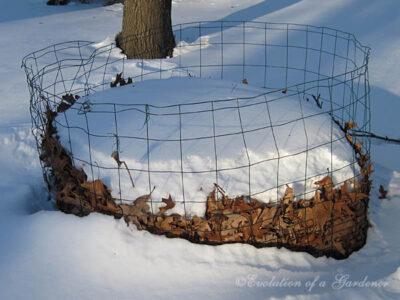|
Listen To The Article
|
Winter composting shouldn’t be a hassle. There are many easy ways to create and maintain usable compost year-round, and winter composting actually has several advantages.
It produces fertilizer for spring planting, so there is no rush to the garden center to pick up compost. Outdoor bins can handle more compost than indoor bins or containers. Winter composting can also act as a secondary heat source for a greenhouse or cold frame. Produce added to compost in the winter decomposes more slowly, and though it may freeze it will thaw, and this continual process breaks down organic fibers. This is how winter temperatures actually help gardeners with the composting.
There are two very important things to remember when deciding to compost over the winter: 1) Be prepared, and, 2) control moisture.
In preparation for winter composting, remember to maintain a balance of nitrogen-based (green) and carbon-based (brown) products. Green scraps usually come from the kitchen in the form of vegetables and other food. Brown scraps would be considered leaves, straw and other plant debris. It is recommended to bag leaves and store them in a dry place. You can then add the brown product to the green when needed. More brown than green is the best balance.
Get Delicious, Nutrient-Dense Heirloom Seeds Here!
Moisture control is essential in having a successful winter compost. Pile systems can prove difficult in this respect, because rain can soak into the ground and get sucked up by the compost, making it too wet. To combat this, make sure the pile is covered and secured well.
Composting leaves
Not only can you compost food scraps, but you can also compost leaves on their own. Usually this type of composting is used to mix with soil as an organic additive. To do this, gather your leaves into a desired place, being around four feet in diameter, and three feet deep. Place a plastic sheet on top and weigh down the edges with any suitable heavy objects. In about five months, the leaves will be all brown, dark and crinkly. This dark pile of leaves shows it is ready to be used.
There are many ways to help make winter composting enjoyable and convenient. First, place your compost close to your back door, rather than in some far corner of your property. Another tip for faster composting is to set your compost in a warm, sunny part of your yard. You can make bins out of hay or straw, and layer with leaves. Store scraps indoors, placed in containers with a lid to control any smell. By doing this, you only have to make trips out to the compost pile every few days or so.
You can compost inside during the winter by using worms (red wiggler worms to be exact). That’s right: Our little, wiggly friends assist in a type of composting called Vermincomposting. Since worms can’t handle the frigid winter cold outside, they are only for indoor composting use. Worms are wonderful garbage-eating machines. They can eat and expel their own body weight every single day. Using worms can create finished compost in just two months. Bins for this type of composting can be kept in the garage or basement where it can still be cool but not freezing.
Take advantage of tumblers
Compost tumblers can be used for year-round garden composting. Tumblers are built on a support so it can be turned over to totally mix the contents. There are vents for air flow on the sides, and tumblers are easy to relocate. Wildlife can’t get into the tumblers to disturb the compost because the tumblers have lids and are elevated off the ground.
Compost bins are similar to compost tumblers, with the difference being bins are stationary. Bins usually have open bottoms, sitting directly on the earth. Scraps are put in the top, compost is removed from the bottom. You treat the bin the same way you would the tumbler. Add dry leaves and materials when you dump your kitchen scraps. As mentioned before, it is a good idea to place your bin in a sunny, warm area to aid in decomposition. These bins are good for continuous, year-round composting. They can handle scraps from not only the kitchen, but garden trimmings of vegetables or flowers as well.
Compost piles allow worms to crawl right up into the thick of the composting area. Piles are the simplest and easiest way to compost. You can start with a pile of sticks, and then add compost (green to brown.) Follow this by adding horse manure or cow manure; this will kick start the whole decomposition process. Remember to turn the pile over every once in a while and cover with a dark tarp. Piles must be insulated by straw, newspapers or even leaves. Most of the ready-to-use compost will be at the bottom of the pile by spring. Make sure your tarp is secured, as wildlife love to dig through compost piles.
The cold weather of winter should not put a halt on composting, and there are many ways to continue during the cold months. With it being so easy, anyone can do it, rain or shine — or even snow.
Do you have any winter composting tips? Share them in the section below:
